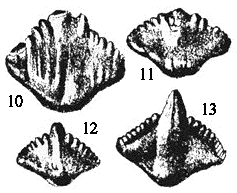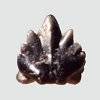|
"The crown of these teeth is usually wider than high, and the base is
extended downward at the middle in a rounded prominence, and backward
posteriorly in a similar prominence. The summit rises in a tapering
point, and the lateral acute borders exhibit seven or eight denticles
successively decreasing towards the base. The teeth of figure 10, 11
have the main point worn off and the lateral denticles more or less
abraded. The tooth of figure 12 has the main point partially worn off,
and even that of fig. 13 has the extreme point somewhat blunted by
abrasion.
The root of these teeth is a shallow basis with a trilateral outline, the angles rounded and the lateral ones slightly projecting." |
 |
| Acrodobatis serra from the Ashley phosphate beds as described by Leidy (1877) |




